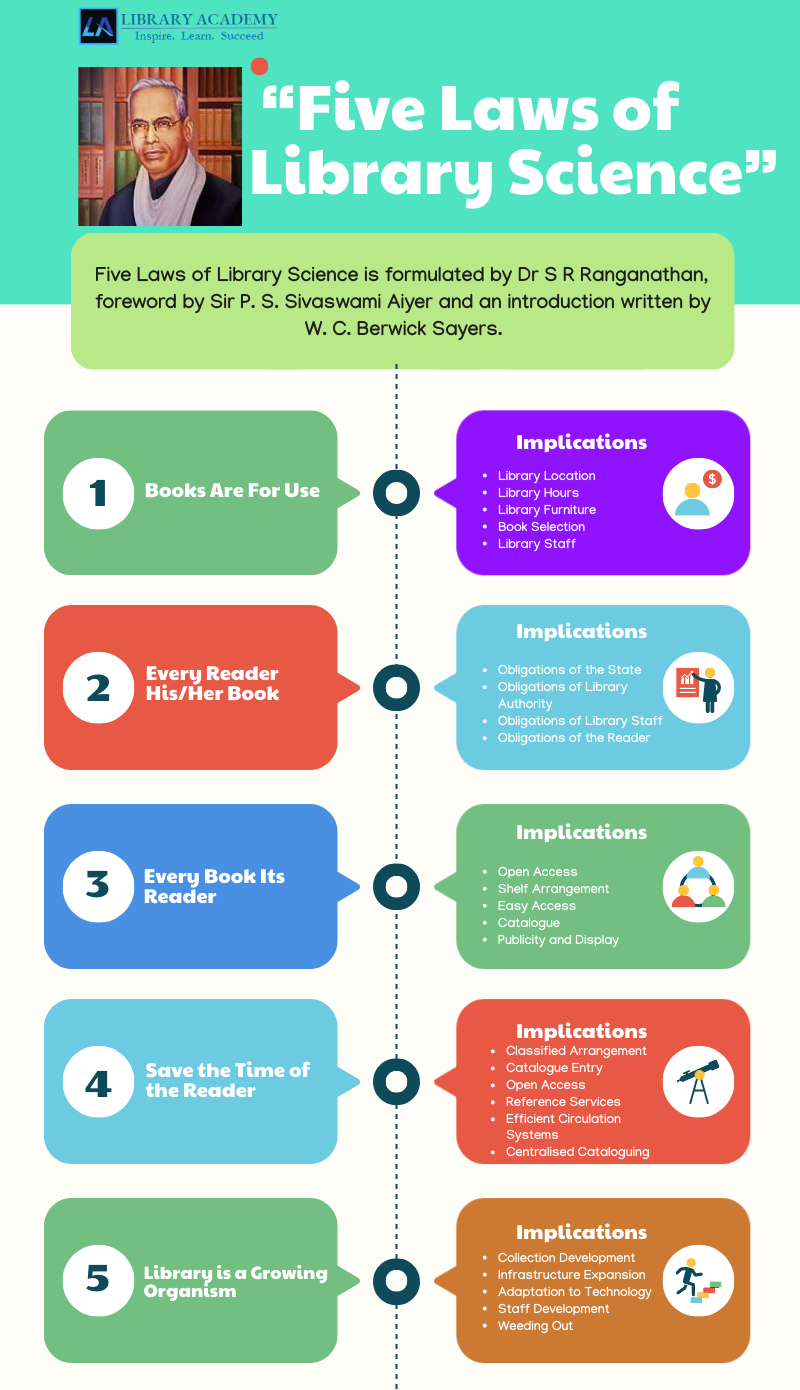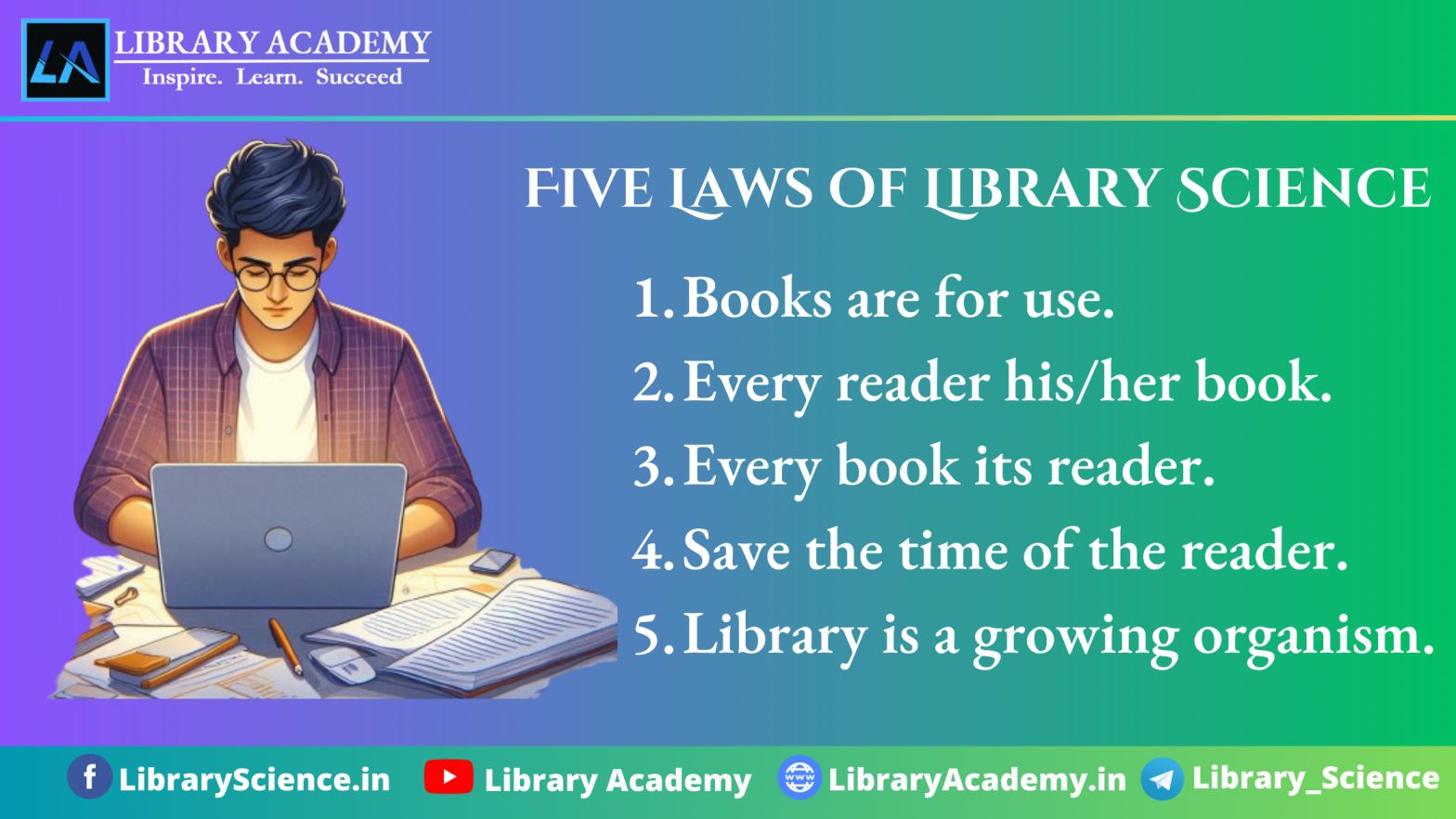Dr. S.R. Ranganathan’s ” five laws of library science were formulated in 1928. He published the famous book titled “Five Laws of Library Science” by the Madras Library Association in 1931. Five Laws of Library Science, foreword by Sir P. S. Sivaswami Aiyer, and an introduction written by W. C. Berwick Sayers.
Dr Shiyali Ramamritra Ranganathan (1892–1972) was an eminent librarian, educator, philosopher, and mathematician. He made significant contributions to the field of library science, with his most notable achievement being the formulation of the Five Laws of Library Science. These laws were developed in 1928 and published in his book “Five Laws of Library Science” in 1931. These laws have since become fundamental guiding principles for library professionals worldwide, emphasizing the purpose and function of libraries in serving their communities.
The 5 Laws of Library Science are:
- 1st Law of Library Science: Books are for use.
- 2nd Law of Library Science: Every reader his/her book.
- 3rd Law of Library Science: Every book its reader.
- 4th Law of Library Science: Save the time of the reader.
- 5th Law of Library Science: Library is a growing organism.
Each of these laws encapsulates a core philosophy about libraries and their operations, serving as a framework for how libraries should function to best serve their users.

1. Books Are For Use (First Law)
The first law emphasizes that the primary purpose of a library is to make books available for use, rather than merely storing and preserving them. Historically, libraries were seen as repositories for the preservation of knowledge. However, with the rise of modern libraries, the focus has shifted to providing access to information.
Implications:
- Library Location: Libraries should be centrally located to be easily accessible to their users.
- Library Hours: Libraries should have flexible hours to accommodate the needs of the community.
- Library Furniture: Furniture should be comfortable and functional, with easy access to books.
- Book Selection: Selection should cater to the needs of the present and potential users, ensuring books are well-maintained and accessible.
- Library Staff: The staff should be well-trained, knowledgeable, and service-oriented to assist users effectively.
2. Every Reader His Book (Second Law)
The second law focuses on ensuring that every individual, regardless of age, sex, or educational background, has access to books that meet their needs and interests.
Implications:
- Obligations of the State: The state should ensure the establishment and maintenance of library systems through legislation and financial support.
- Obligations of Library Authority: The library authority must carefully select books and staff to meet the diverse needs of users.
- Obligations of Library Staff: Staff should actively assist users in finding materials that meet their needs and provide additional services such as reference assistance and bibliographic support.
- Obligations of the Reader: Readers should follow library rules and make effective use of the resources provided.
3. Every Book Its Reader (Third Law)
The third law emphasizes that for every book, there is a reader who would find it useful. It is the responsibility of the library staff to connect books with their appropriate readers.
Implications:
- Open Access: Allowing users to browse shelves freely increases the chances of finding the right book.
- Shelf Arrangement: Books should be arranged in a classified order to make browsing easier.
- Easy Access: Shelves should be within reach of the average user, and books should be easily accessible.
- Catalogue: A detailed and well-maintained catalogue is essential to help users discover the books they need.
- Publicity and Display: Publicity through various channels and proper display of new books helps in connecting books with their potential readers.
4. Save the Time of the Reader (Fourth Law)
The fourth law focuses on efficiency in library operations to minimize the time a user spends searching for and obtaining materials.
Implications:
- Classified Arrangement: Books should be arranged to allow easy access and quick retrieval.
- Catalogue Entry: Detailed cataloguing, including cross-references, helps users find materials quickly.
- Open Access: Supports the idea of allowing users to browse freely to find what they need without delay.
- Reference Services: Professional and knowledgeable staff should provide quick and accurate assistance to users.
- Efficient Circulation Systems: The circulation process should be streamlined to minimize book loan and return wait times.
- Centralised Cataloguing: Pre-natal centralized cataloguing is encouraged to save staff time and effort.
5. Library Is a Growing Organism (Fifth Law)
The fifth law highlights that libraries are dynamic entities that must continuously evolve and grow to meet the changing needs of their users.
Implications:
- Collection Development: Libraries must continuously update and expand their collections to stay relevant.
- Infrastructure Expansion: The physical infrastructure, including space and technology, should grow in response to the library’s expanding role.
- Adaptation to Technology: Libraries must embrace new technologies to improve service delivery and operational efficiency.
- Staff Development: Continuous professional development for library staff is essential to meet the evolving needs of the library and its users.
- Weeding Out
Frequency Ask Questions (FAQ) with Explanation
1. What are the Five Laws of Library Science
- Ans: Books are for use.
- Every reader his/her book.
- Every book its reader.
- Save the time of the reader.
- Library is a growing organism.
2. Who is the Father of the Five Laws of Library Science?
Ans: Dr. S. R. Ranganthan
3. Who Published the Five Laws of Library Science?
Ans: Madras Library Association
4. Which Year Published Five Laws of Library Science?
Ans: 1931
5. Who is forwarded Five Laws of Library Science
Ans: Sir P. S. Sivaswami Aiyer
6. Who wrote the introduction of the Five Laws of Library Science?
Ans: W. C. Berwick Sayers.
Conclusion
Dr Ranganathan’s Five Laws of Library Science remain as relevant today as they were when they were first formulated. They provide a timeless foundation for library management, emphasising the importance of user-centred service, efficiency, and the continuous evolution of library practices to serve the needs of society.
Source: NIOS, EpgPathsala, E Gyankosh
 Subscribe YouTube Channel
Subscribe YouTube Channel

